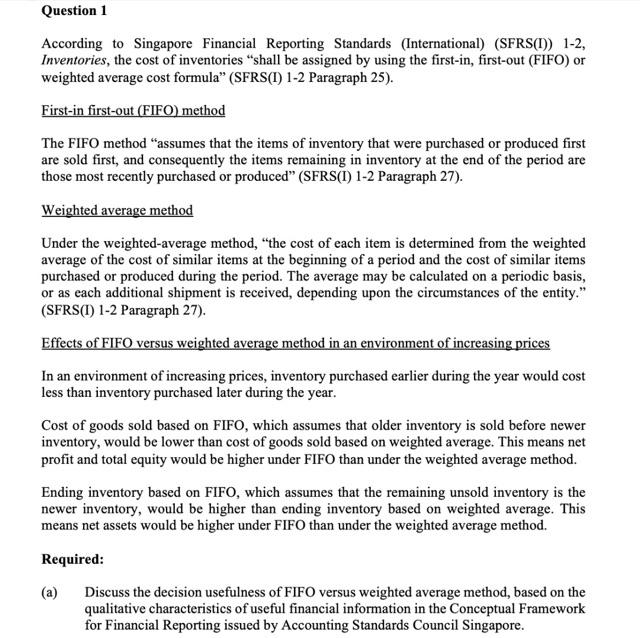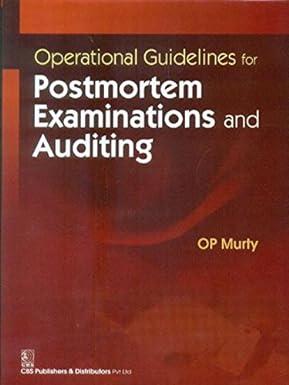
Question 1 According to Singapore Financial Reporting Standards (International) (SFRS(I)) 1-2, Inventories, the cost of inventories "shall be assigned by using the first-in, first-out (FIFO) or weighted average cost formula (SFRS(1) 1-2 Paragraph 25). First-in first-out (FIFO) method The FIFO method assumes that the items of inventory that were purchased or produced first are sold first, and consequently the items remaining in inventory at the end of the period are those most recently purchased or produced" (SFRS(1) 1-2 Paragraph 27). Weighted average method Under the weighted average method, "the cost of each item is determined from the weighted average of the cost of similar items at the beginning of a period and the cost of similar items purchased or produced during the period. The average may be calculated on a periodic basis, or as each additional shipment is received, depending upon the circumstances of the entity." (SFRS(I) 1-2 Paragraph 27). Effects of FIFO versus weighted average method in an environment of increasing prices In an environment of increasing prices, inventory purchased earlier during the year would cost less than inventory purchased later during the year. Cost of goods sold based on FIFO, which assumes that older inventory is sold before newer inventory, would be lower than cost of goods sold based on weighted average. This means net profit and total equity would be higher under FIFO than under the weighted average method. Ending inventory based on FIFO, which assumes that the remaining unsold inventory is the newer inventory, would be higher than ending inventory based on weighted average. This means net assets would be higher under FIFO than under the weighted average method. Required: (a) Discuss the decision usefulness of FIFO versus weighted average method, based on the qualitative characteristics of useful financial information in the Conceptual Framework for Financial Reporting issued by Accounting Standards Council Singapore. Question 1 According to Singapore Financial Reporting Standards (International) (SFRS(I)) 1-2, Inventories, the cost of inventories "shall be assigned by using the first-in, first-out (FIFO) or weighted average cost formula (SFRS(1) 1-2 Paragraph 25). First-in first-out (FIFO) method The FIFO method assumes that the items of inventory that were purchased or produced first are sold first, and consequently the items remaining in inventory at the end of the period are those most recently purchased or produced" (SFRS(1) 1-2 Paragraph 27). Weighted average method Under the weighted average method, "the cost of each item is determined from the weighted average of the cost of similar items at the beginning of a period and the cost of similar items purchased or produced during the period. The average may be calculated on a periodic basis, or as each additional shipment is received, depending upon the circumstances of the entity." (SFRS(I) 1-2 Paragraph 27). Effects of FIFO versus weighted average method in an environment of increasing prices In an environment of increasing prices, inventory purchased earlier during the year would cost less than inventory purchased later during the year. Cost of goods sold based on FIFO, which assumes that older inventory is sold before newer inventory, would be lower than cost of goods sold based on weighted average. This means net profit and total equity would be higher under FIFO than under the weighted average method. Ending inventory based on FIFO, which assumes that the remaining unsold inventory is the newer inventory, would be higher than ending inventory based on weighted average. This means net assets would be higher under FIFO than under the weighted average method. Required: (a) Discuss the decision usefulness of FIFO versus weighted average method, based on the qualitative characteristics of useful financial information in the Conceptual Framework for Financial Reporting issued by Accounting Standards Council Singapore







